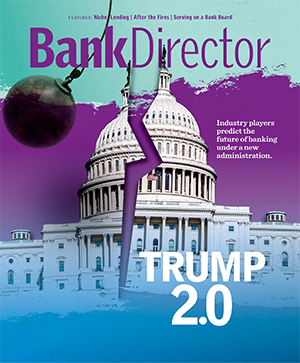Donna Horrigan has a passion for helping banks to drive customer acquisition and loyalty through performance improvement learning solutions. For over 25 years as a sales professional, leader, collaborator and trusted advisor specializing in organizational change and long-term improvement she has been a steadfast client advocate. Donna brings passion and infectious enthusiasm to all her client engagements.

The Power of Coaching in Banking
Investing in the development of internal talent encourages employees to achieve more for themselves, for their customers and for the bank.
Brought to you by Integrity Solutions

Widespread digital transformation is changing the game for businesses across industries, particularly for financial institutions. Banks are investing heavily in digital banking and generative AI to improve efficiencies and handle more of the predictable, repetitive and transactional tasks.
But that hasn’t eliminated the need for the human touch. In fact, customers not only still value the branch, they’re increasingly relying on the personalized service and advice they get from bankers who are empathetic to their situation and focused on addressing their specific needs, values and aspirations.
As the playing field changes and the industry faces a significant talent shortage, bankers who can fill these consultative roles are in hot demand. Talent strategies can’t be limited to just hiring new people. Banks must also make sure their current employees have the skills and desire to build the kind of trusted relationships and human connection customers are craving. Positioning the bank for long-term success will require investing in people as well as technology. That starts with leadership because leaders who are great coaches are key to both attracting and keeping great talent.
Empowerment Through Coaching
Talented people want to learn and grow, and they want to work at organizations and for leaders who prioritize continuous development. It shows them that they’re valued and that the leader sees their potential and has a vested interest in their future. That’s a powerful confidence builder, and it’s one of the primary reasons people stay with organizations.
How to Coach
While most leaders recognize that coaching is important, we’ve found many aren’t doing it consistently, effectively or at all. Coaching isn’t about a once-a-year review or “catch-and-punish” style feedback. Today’s talent needs and expects frequent coaching that empowers them to solve problems and gives them the tools to overcome self-limiting behaviors, take ownership of issues and make smart decisions. That requires an ongoing commitment — by both the leader and the employee — to grow and evolve winning behaviors and skills.
With customers looking for a more human-centered, consultative approach, coaching is critical for helping shift people’s mindsets about their role and building the capability and confidence to give customers what they need, not just what they ask for. Employees who are used to playing a more transactional role often struggle with seeing themselves as an adviser or, worse, in their view, a salesperson. They need to understand the purpose of what they’re doing and why they’re doing it to add value to your business.
A great coach helps bankers realize that sales equals service because both are about creating meaningful value for the customer. Selling isn’t “bothering” the customer or pushing them to buy something they don’t need. It’s asking thoughtful questions, being prepared for that customer interaction and being genuinely curious about that person’s financial needs so you can make the best recommendations. Once bankers make that mental shift, they feel an obligation to have deeper consultative conversations, and that’s how they begin to forge trusting relationships that truly differentiate the bank. It also makes the job a lot more personally fulfilling.
A Coaching Culture
One of the common pitfalls we see in training implementations is that organizations drop the ball on ongoing coaching and accountability. No matter what kind of training it is, whether it’s a sales program or a golf clinic, if you want to achieve long-term results, there must be consistent reinforcement, practice, coaching and support. To build habits and sustain change, bank managers need to be equipped to have regular coaching conversations with their employees that encourage them to set goals, plan how to get there and create a process to stay on track.
Ultimately, leaders set the tone for the coaching culture, starting with executives modeling the behaviors that they want throughout the bank. If you’re a manager, be as curious about your people as you were on the day you first interviewed them. Find out what motivates them and where there might be misalignment. Show them you believe that they have what it takes. Great coaches tend to see more in their players than they even see in themselves, and that’s what helps people build conviction and break through to new levels of performance.
If you develop your people so they find fulfillment and purpose in what they’re doing, they’ll not only want to stay, they’ll want to achieve more — for themselves, for their customers and for the bank.


